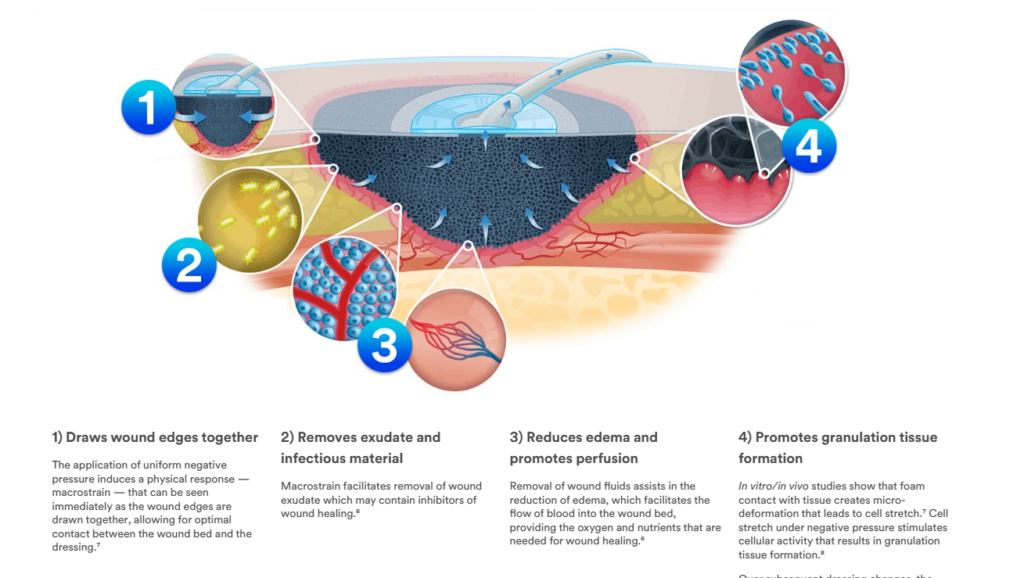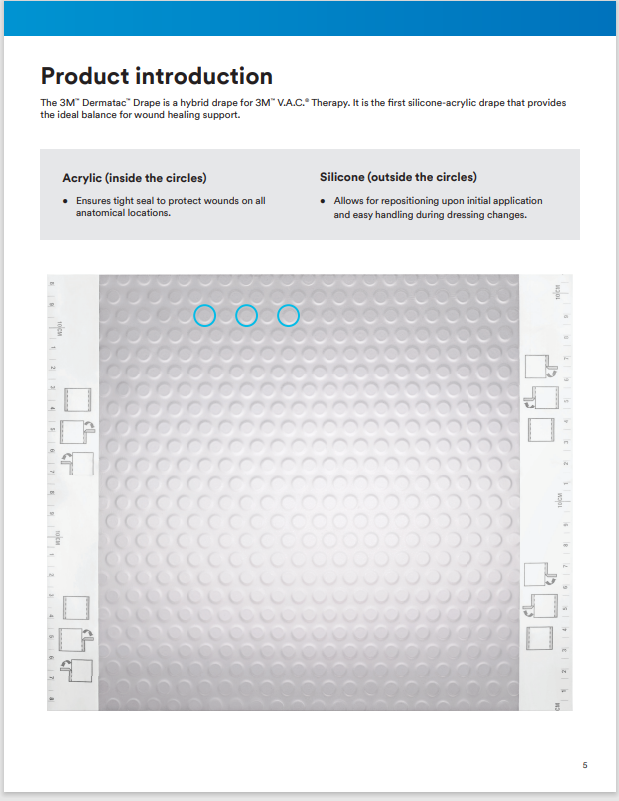Discover how the 3M Bioskills Hands-on Lab shapes healthcare education, focusing on Prevena and Instill NPWT technologies for improved patient care.
Introduction
In the field of healthcare, continuous education and training are vital for professionals to stay updated with the latest advancements. One such innovative program is the 3M Bioskills Hands-on Lab. The 3M Bioskills Hands-on Lab plays a pivotal role in providing immersive training experiences for healthcare professionals. This article delves into the significance of the lab in healthcare education, with a particular emphasis on Prevena and Instill NPWT technologies. Let’s explore how this cutting-edge cadaver lab enhances medical expertise and shapes the future of patient care.
Overview of Negative Pressure Wound Therapy with instillation
NPWT with instillation (NPWTi), is an innovative approach to wound care. It involves the use of a specialized vacuum system that applies negative pressure to the wound while simultaneously delivering a solution into the wound bed. This therapy helps in cleansing the wound, removing bacteria and debris, promoting granulation tissue formation, and accelerating the healing process.
NPWT with instillation has shown promising results in the management of various types of wounds, including chronic wounds, surgical wounds, and traumatic wounds. By combining the benefits of negative pressure therapy and wound instillation, this technique offers an effective and efficient solution for wound care.

Appropriate wounds for 3M Veraflo Therapy
- Traumatic wounds
- Diabetic wounds
- Venous leg ulcers
- Pressure injuries/ulcers
- Surgical, including dehisced, wounds
- Wounds with exposed intact bone
- Wounds with treated, underlying osteomyelitis
- Infected or contaminated wounds in the presence of orthopedic
fixation hardware - Full-thickness burns after excision
- Wounds resulting from evacuation of a hematoma and when
hemostasis is achieved - Wounds that are a bridge between staged/delayed amputation
Recommended compatible solutions
- Normal saline
- Hypochlorous acid solution
- Sodium hypochlorite solution
(dilute Dakin’s solution 0.125% or
quarter strength) - Acetic acid solution (0.25% to 1.0%)
- Polyhexamethylene biguanide (0.1%) +
betaine (0.1%)

Prevena Therapy
Prevena therapy is a specific type of negative pressure wound therapy (NPWT) that utilizes a closed incisional management system. It is designed to manage surgical incisions and reduce the risk of complications such as surgical site infections. Prevena therapy creates an airtight seal over the incision, allowing for the application of negative pressure to remove fluid and promote healing.
The benefits of Prevena therapy include
- Reduced risk of infection: By providing an airtight seal, Prevena therapy minimizes the exposure of the incision to external pathogens, reducing the risk of infection.
- Enhanced wound healing: The application of negative pressure stimulates blood flow and promotes tissue perfusion, accelerating the healing process.
- Decreased post-operative complications: Prevena therapy helps prevent complications such as dehiscence (wound opening) and seroma formation, leading to improved patient outcomes.
- Prevena can be used on intact skin to help reduce edema in surrounding tissue.
Prevena Therapy; Mechanism of Action
- Acts as a barrier to external contamination
- Delivers continuous -125mmHg up to 7 days
- Removes fluids and infectious materials
- Helps to hold incision edges together
- Decreases lateral tensions of sutured / staples incisions
- Reduces edema
- Under negative pressure, reticulated open-cell foam dressing collapses to its geometric center
- Contours allow for even distribution of negative pressure
- Skin interface layer contains 0.019% ionic silver to reduce bacterial colonization
- Available in multiple sizes and configurations for a variety of patients

The Role of 3M Bioskills Hands-on Lab in Healthcare Education
The 3M Bioskills Hands-on Lab plays a crucial role in healthcare education by providing a controlled environment for healthcare professionals to practice and refine their skills. It offers a range of training programs and workshops that extend beyond traditional teaching methodologies. By combining innovative technologies and interactive learning, the lab offers a unique training experience for healthcare professionals. Let’s take a closer look at the key aspects of the lab’s role.
1. Experiential Learning in a Controlled Environment
The lab provides healthcare professionals with an opportunity to engage in experiential learning within a controlled environment. Through hands-on activities, clinicians can refine their skills, learn new techniques, and master complex procedures. This immersive experience allows them to bridge the gap between theory and practice, leading to improved patient care.
2. Cadaver Lab: A Realistic Learning Environment
The 3M Bioskills Hands-on Lab features a state-of-the-art cadaver lab, offering a realistic learning environment. Cadaveric dissection enables healthcare professionals to gain an in-depth understanding of human anatomy, ensuring precision in surgical procedures. By working with actual human tissue, clinicians can develop the dexterity and familiarity required for successful interventions.
3. Focus on Prevena and Instill NPWT Technologies
Prevena and Instill NPWT (Negative Pressure Wound Therapy) are revolutionary technologies that have transformed the management of complex wounds. The 3M Bioskills Hands-on Lab provides dedicated training on these advanced therapies, enabling healthcare professionals to develop expertise in their application. By mastering these technologies, clinicians can enhance patient outcomes and reduce healing time.
4. Interactive Workshops and Collaborative Learning
The lab organizes interactive workshops and fosters collaborative learning among healthcare professionals. These workshops encourage knowledge sharing, allowing participants to learn from each other’s experiences and perspectives. By facilitating interdisciplinary interactions, the lab promotes a holistic approach to healthcare and cultivates a collaborative mindset among professionals.
5. Continuous Professional Development
As the field of healthcare evolves, ongoing professional development is essential for clinicians to adapt and excel. The lab offers a range of courses, workshops, and training programs that enable healthcare professionals to enhance their knowledge and skills. By participating in these educational activities, clinicians can stay up-to-date with the latest respective fields advancements in their
Frequently Asked Questions (FAQs):
Q: What are the prerequisites for attending a training in the 3M Bioskills Hands-on Lab?
A: The prerequisites vary depending on the specific course or workshop. However, most programs require participants to have a relevant healthcare background and professional experience in their respective fields.
Q. How do I Sign up for a BioSkills Event?
A. Reach out to your local 3M REP for any current event that may be available to you.
Q: Can healthcare professionals from different specialties participate in the lab’s training programs?
A: Yes, healthcare professionals from various specialties are welcomed. The lab’s diverse training programs cater to the specific needs of clinicians from different fields, promoting interdisciplinary collaboration and fostering a comprehensive approach to healthcare.
Q: Are the training programs at the 3M Bioskills Hands-on Lab accredited?
A: Yes, the training programs offered by the 3M Bioskills Hands-on Lab are often accredited by relevant professional organizations. These accreditations ensure that the training meets industry standards and provides participants with valuable continuing education credits.
Q: What are the benefits of learning in a realistic cadaver lab setting?
A: Learning in a realistic cadaver lab setting offers several benefits. It allows healthcare professionals to practice procedures on real human tissue, gaining hands-on experience and improving surgical precision. The cadaver lab setting replicates the conditions and challenges encountered in real-life surgical scenarios, preparing clinicians for complex interventions.
Conclusion:
The 3M Bioskills Hands-on Lab plays a vital role in healthcare education by providing immersive and experiential learning opportunities. Through its state-of-the-art cadaver lab and focus on Prevena and Instill NPWT technologies, the lab equips healthcare professionals with the skills and knowledge necessary to deliver exceptional patient care. By fostering collaboration, continuous learning, and innovation, the lab contributes to the advancement of medical science and shapes the future of healthcare. Embracing the opportunities offered by the 3M Bioskills Hands-on Lab can propel healthcare professionals toward excellence and positively impact patient outcomes.






This is a really good tip particularly to those new to the blogosphere. Short but very precise info… Thanks for sharing this one. A must read post!